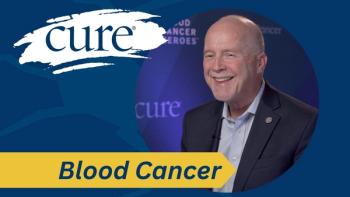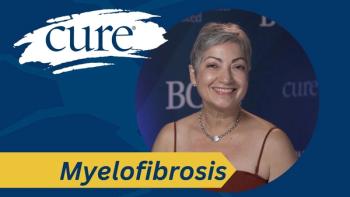
- CURE® Breast Cancer 2022 Special Issue
Will There Be a Resurgence of Ki-67 Scoring in Breast Cancer?
An FDA approval put Ki-67 scoring — which may predict tumor growth — in the spotlight, but what that means long term to patients depends on who you ask.
The speed at which cancer cells grow can be an important factor in determining cancer treatment. Among the best-known biomarkers for the rate of cancer growth is a protein known as Ki-67, which is expressed when tumor cells divide.
A high Ki-67 index indicates aggressive tumor growth.
For example, Kate Laseter of Thornton, Colorado, was diagnosed with stage 2 invasive ductal carcinoma in September 2021 and informed that her Ki-67 score was 65%. Of note, the median Ki-67 score is 15%.
As a histological technician with Theralink Technologies, Laseter immediately knew what that meant.
“It was very aggressive and growing rapidly and had invaded everything,” she recalls. “I looked at my (results) ... and I had less than 10% normal tissue in my biopsy.”
Because Laseter was just 29 when she noticed a lump in her breast, she was told that it was probably just a fibrous mass and to wait and see. She refused and demanded a biopsy.
Based on her high Ki-67 score, she was placed on treatment immediately and received a chemotherapy regimen that included carboplatin and docetaxel in combination with the targeted therapies Herceptin (trastuzumab) and Perjeta (pertuzumab). She also underwent a bilateral mastectomy.
In March 2022, she was declared in remission and cancer-free.
“My Ki-67 score clearly changed how quickly my care team wanted to start treatment on me,” Laseter observes. “If they hadn’t performed that test, my tumor could have just kept growing and possibly metastasized. It’s important for patients to educate and advocate for themselves.”
Using Ki-67 to Determine Tumor Growth
Ki-67 is used to determine tumor growth in several types of cancer including breast cancer, says Dr. Ruth O’Regan, chair of the department of medicine at the University of Rochester in New York.
“We use it to determine the type of breast cancer a patient has, which helps us make treatment decisions,” O’Regan notes. “It’s commonly used in cancers that express estrogen receptors, which makes up about two-thirds of the breast cancers that we treat.”
Ki-67 has been used to determine the rate of tumor growth for many years, but there have been issues around the consistency and reproducibility of clinical scoring of Ki-67 levels. However, using more automated technology to read scores and consensus meetings of the experts in the area have led to more widespread acceptance.
The protein was given a boost in October 2021 when the Food and Drug Administration (FDA) approved Verzenio (abemaciclib), a CDK4/6 inhibitor, with endocrine therapy for adjuvant treatment (additional therapy given after primary treatment to lower the risk of the cancer returning) of adults with hormone receptor-positive, human epidermal growth factor receptor 2 (HER2)- negative, node-positive, early breast cancer at high risk of recurrence and a Ki-67 score of 20% or greater.
“This was a game changer because it was the first FDA approval of a CDK4/6 inhibitor in the curative setting, notably after this class of drugs had dramatically improved outcomes when added to hormone therapy for metastatic breast cancer,” observes Dr. Heather McArthur, an associate professor in the Department of Internal Medicine at UT Southwestern Medical Center in Dallas.
“It’s hugely impactful to have the addition of a CDK4/6 inhibitor in our arsenal of drugs for early-stage breast cancer.”
The efficacy of Verzenio with endocrine therapy was evaluated in monarchE, a multicenter clinical trial that included women and men with the above-described form of early breast cancer with a high risk of recurrence.
Patients received either two years of Verzenio plus their physician’s choice of standard endocrine therapy or standard endocrine therapy alone.
In patients with high risk of recurrence and a Ki-67 score of 20% or greater, the trial showed a statistically significant improvement in invasive-disease-free survival (the time after treaatment that a patient survives without signs of cancer) among the cohort receiving Verzenio.
'Tension Between Accuracy and Efficacy'
Ki-67 levels are usually scored at the time of diagnosis. When a tumor is biopsied, a small sample is stained through a process known as immunohistochemistry, which reveals the cells expressing Ki-67.
In some labs, pathologists examine the slide and estimate the number of cells rather than actually count them, notes Dr. David Rimm, a professor in the department of pathology at Yale University School of Medicine in New Haven, Connecticut.
“Some would only count a few cells, and some would count more because the more cells you count, the more accurate you are, though it takes more time,” he explains. “So there was a sort of tension between accuracy and efficiency for reading this test.”
For breast cancer, a Ki-67 score of 5% or less is considered low, and greater than 30% is considered high.
“Those are the cutoff points at which we can have great concordance among pathologists, and the International Ki67 in Breast Cancer Working Group also recommends those cut points,” says Rimm.
The FDA’s approved cutoff point for the use of Verzenio is 20%, which could result in different interpretations among pathologists.
“The maker of (Verzenio) didn’t take that into account when they designed their cut point,” Rimm says. “There are laboratories that still use a cut point of 12%, 13% or 14%, which is what led to the problems of nonreproducibility in the first place. It’s tough for pathologists to be really reproducible in that range, even counting every cell.”
In response, the American Society of Clinical Oncology and the National Comprehensive Cancer Network issued their own recommendations for consideration of Verzenio in high-risk patients, says McArthur, although their recommendations were agnostic of Ki-67 and did not include a cutoff.
“Those decisions were made based on a variety of reasons, namely the fact that not every cancer center performs Ki-67 testing, that Ki-67 has been a notoriously unreliable biomarker with a lot of interobserver and interlab variability, and uncertainty as to the optimal cutoff for determining high-versus-low scores,” McArthur notes.
“It’s a test that’s been fraught with challenges over the years, and it was interesting that the FDA decided to include the 20% cutoff in their approval.”
Concern over the accuracy of Ki-67 scoring may also result from the inherent heterogeneity of tumors, adds Rimm.
“Even though we can measure the amount of Ki-67 relatively accurately, we’re only sampling a tiny piece of the tumor,” he explains. “When we make a diagnosis of cancer, we sample less than 1% of the tumor, so if proliferation is heterogeneous (varies by location), it might be inaccurate or only represent part of the tumor.”
Moving to the Digital Age
As medicine moves into the era of digital pathology, automated approaches to scoring Ki-67 are becoming more commonly accepted, Rimm notes.
“I led the work by the (International Ki67 in Breast Cancer Working Group), which showed that an automated assessment was as good or even better than the assessment by counting pathologists,” he says. “However, we didn’t want to require automated assessment because there are still sites that don’t have the machinery to do it.”
UT Southwestern is among the institutions that do not use automated assessment to score Ki-67 in breast tumors, although it does see it more consistently in outside reports, says McArthur.
“We typically repeat all biomarkers in-house to ensure that our breast cancer-dedicated pathologists agree with outside interpretations, especially when they are automated,” she adds. “We are pretty rigorous in confirming those results within our breast cancer-dedicated pathology service.”
A tumor’s Ki-67 score helps establish the rate of tumor growth, but its influence in developing treatment options often depends on the oncologist in charge, says Dr. Joseph Geradts, a clinical professor in the department of pathology and laboratory medicine at the East Carolina University Brody School of Medicine in Greenville, North Carolina.
“The oncologists at (East Carolina University) usually make treatment decisions in the absence of a Ki-67 index, and that’s true for many oncologists around the country,” he explains.
“This is because they already have a lot of information that allows them to make treatment decisions, such as the routine pathology report, which includes the tumor grade and mitotic index, both of which are correlated with the Ki-67 index, and other assays such as Oncotype DX. It’s a relatively small group of patients for whom Ki-67 adds a lot to what is already known, though there are oncologists who rely on it more heavily.”
In addition to helping determine the rate of tumor growth at diagnosis, Ki-67 expression can be a useful monitor of tumor response to preoperative endocrine therapy.
“In many cases, preoperative endocrine or chemotherapy is very effective, but sometimes it is not,” Geradts says. “That’s where Ki-67 comes in because it has been shown that in those tumors where the Ki-67 index goes down after treatment, the patient benefits from that therapy. That’s another area where Ki-67 has proved useful, but admittedly, it’s a relatively small percentage of patients.”
Determining Treatment
Although Ki-67 may play a minimal role in deciding treatment for some patients, an extremely high Ki-67 score can be quite determining for others.
Megan-Claire Chase of Dunwoody, Georgia, had her treatment influenced by a high Ki-67 score. After months of unusual symptoms followed by the discovery of a hard lump in her left breast, Chase was diagnosed in September 2015 with stage 2 invasive lobular breast cancer.
Her treatment regimen included 16 rounds of chemotherapy (Adriamycin PFS [doxorubicin hydro- chloride], Cytoxan [cyclophosphamide] and Taxol [paclitaxel]), 33 rounds of radiation, and a lumpectomy, reduction and reconstruction.
“The biopsy of my tumor showed that I was ER (estrogen receptor) positive (95%), PR (progesterone receptor) positive (99%), HER2 negative, and my Ki-67 score was 60%,” says Chase, who is the breast cancer program director at SHARE Cancer Support.
“With that plus genetic counseling, my family history and the fact that I had an unknown variant, my oncologist felt it was important to give me the motherload of chemotherapy to kill everything.”
As she entered the survivorship phase, Chase chose another oncologist, who shocked her by telling her that he wouldn’t have recommended chemotherapy even with her high Ki-67 score.
However, Chase did her own research and realized that her Ki-67 score and other factors made her an ideal candidate for the treatment she received.
"The chemo was supposed to, first, contain my tumor from spreading, and then shrink it as much as possible, and that’s what it has done,” she states.
Unlike Laseter, Chase was unfamiliar with Ki-67 at the time of her diagnosis.
Intent on understanding as much as possible about her cancer, she questioned the reasoning behind her recommended treatment regimen.
“I asked, ‘Why are you giving me this? Is this a cookie-cutter treat- ment?’ And I was told no. It was based on several factors, including my Ki-67 score of 60%,” Chase says.
What's on the Horizon
Although the FDA approval of Verzenio with endocrine therapy for early breast cancer put a new spotlight on the role and value of Ki-67, most pathologists believe the approval was a one-off that won’t lead to significantly greater use within cancer pathology.
Of greater interest are technologies that make Ki-67 scoring more reliable and less subjective.
“I believe an automated way of measuring Ki-67 will be important because it takes the subjectivity out of the measurements,” says O’Regan. “But honestly, more and more, we’re moving toward looking at genes rather than proteins in terms of what drives cancer. So it may be that how proliferation is measured will be completely different than what we do now.”
Geradts also believes that digital image analysis is the way of the future, noting, “Ki-67 is very much observer dependent, and that can be eliminated by using computer algorithms. As these algorithms become more commonplace and affordable, we’ll likely see an increased number of laboratories that will choose to quantitate Ki-67 because it will be much more reproducible.”
It all makes for a very exciting time to be treating breast cancer, says McArthur.
“We have had in recent years an unprecedented number of FDA approvals that have had a huge clinical impact in terms of decreasing risk of developing metastatic disease for patients with early-stage breast cancer and improving overall survival for patients who do have metastatic breast cancer,” she says.
“We want to learn more about cell proliferation and other factors so that we can offer more effective treatments to patients who need it and optimize treatment recommendations for those who can achieve those same great outcomes — but with less toxicity in the form of fewer drugs.”
For more news on cancer updates, research and education, don’t forget to
To learn more about Kate Laseter's journey with stage 2 invasive ductal carcinoma and using her experience as an employee at a breast cancer research facility to push back against doctors who minimized her ultrasound findings,
Articles in this issue
about 3 years ago
Self-Advocacy Is Critical in Cancer Careabout 3 years ago
The Fear of Cancer Recurrence is Real, Natural and Nearly Universal



